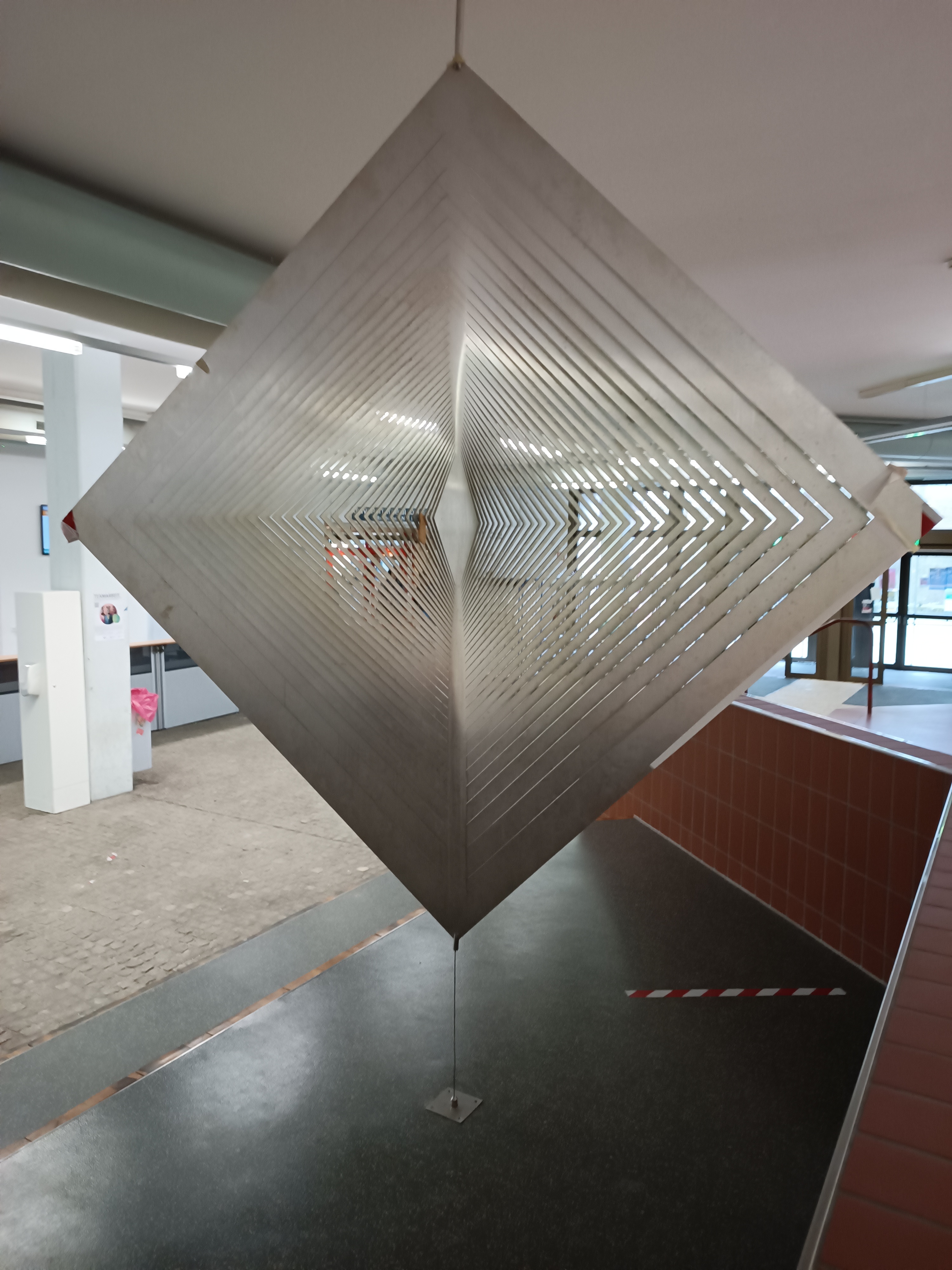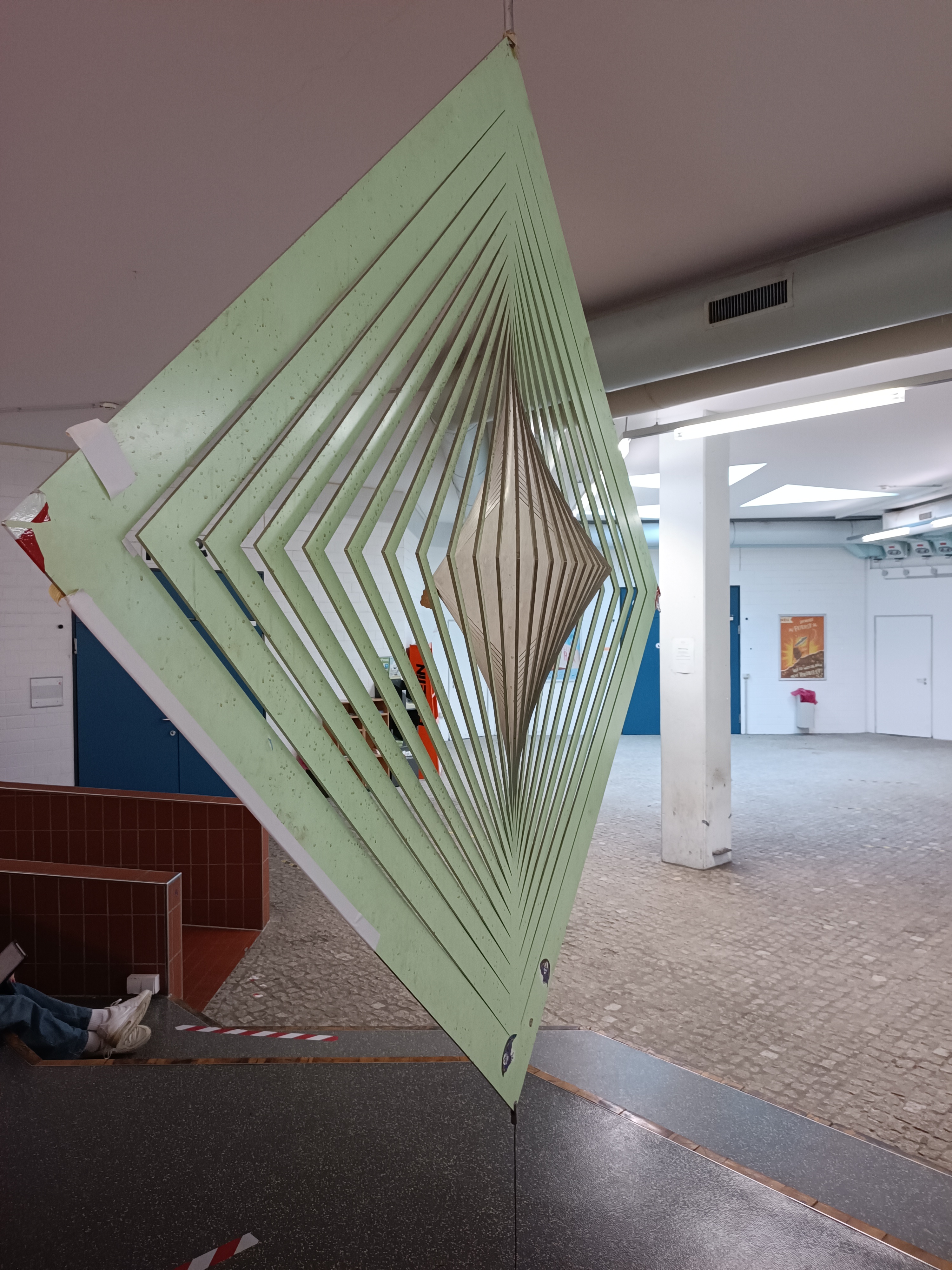Natural Sciences I

The work "Lichtkinetisches Objekt" by Tomitaro Nachi is a fascinating example of the fusion of art, technology, and science.
Tomitaro Nachi, born in 1924 in Yokohama, brought a unique perspective to the art world, shaped by his training as an aircraft designer and test pilot, as well as his later artistic and academic career. His work at the Ulm School of Design and his teaching activities in Japan underscore his interdisciplinary approach, which unites technology, design, and art.
Nachi was deeply fascinated by the idea of infinity, a theme that runs through many of his works. This fascination is reflected in the dynamics and repeating patterns seen in "Lichtkinetisches Objekt."
The "Lichtkinetisches Objekt" is an impressive example of Nachi's lichtkinetic art. It is made of polished aluminum and secured with stainless steel cables, giving it a robust yet elegant appearance. With a side length of 2 meters and the ability to rotate at 0.5 revolutions per minute using a gear motor, the object creates a captivating visual experience.
The two sides of the object—one in bright green, the other in natural aluminum—create an interesting contrast and play with the perception of light and movement. The slow rotation of the object enhances the impression of infinity and continuous change, emphasizing Nachi's central theme.
Installed in the Naturwissenschaften I building at the University of Bayreuth, the object stands in a hall in front of the lecture halls. This placement is significant as it emphasizes the connection between art and science. The slow rotation of the object could be seen as a metaphor for the continuous progress and constant change in science.

Tomitaro Nachi's "Lichtkinetisches Objekt" is a masterpiece that blurs the boundaries between art, technology, and science. It embodies Nachi's fascination with infinity and creates a visual experience that is both aesthetically pleasing and intellectually stimulating. The work is a testament to Nachi's innovative approach and his contribution to art history.

Joachim Bandau's "Verkantete Würfel" presents a modern sculpture that engages with themes of geometry, space, and industrial materials. Created between 1979 and 1980, this two-part work stands prominently on the campus of the University of Bayreuth, near the Naturwissenschaften I building. The sculpture is made of Corten steel, a material known for its weather resistance and for developing a protective patina over time, giving it a characteristic rust-colored appearance.
The sculpture consists of two large, tilted parallelepipeds, each reaching a height of 3 meters. The forms are vertically divided, creating a sense of separation and tension between the two halves. This division is not only physical but also conceptual, inviting viewers to contemplate themes of duality and fragmentation.
The 1.15-meter gap between the two parts emphasizes the void, making it an integral part of the sculpture. This empty space can be interpreted as a metaphor for absence or the invisible connections between separate elements.

The use of Corten steel is significant. This material, often used in construction for its durability and aesthetic qualities, connects the sculpture to industrial and architectural contexts. The rusty appearance of Corten steel also alludes to the passage of time and the effects of natural processes on man-made structures.
The weathered surface of the steel contrasts with the precise, geometric forms of the cubes, creating a dialogue between the organic and the manufactured, the natural and the artificial.
Placed on a university campus, the sculpture engages with its academic environment. The tilted cubes could be interpreted as a symbol of the dynamic and ever-changing nature of knowledge and intellectual pursuits.
The open, grassy surroundings allow viewers to approach the sculpture from various angles, encouraging interaction and diverse perspectives. This placement emphasizes the role of the sculpture as a public artwork meant to be experienced in the daily life of the campus community.
Joachim Bandau's background and artistic development provide additional context for understanding the "Verkantete Würfel." His early works with polyester and aluminum, followed by his exploration of heavier materials like steel and iron, reflect a continuous engagement with materiality and form.
Bandau's participation in significant art events such as documenta 6 and the receipt of prestigious awards underscore his contributions to the field of sculpture. His teaching activities further emphasize his influence on subsequent generations of artists.
